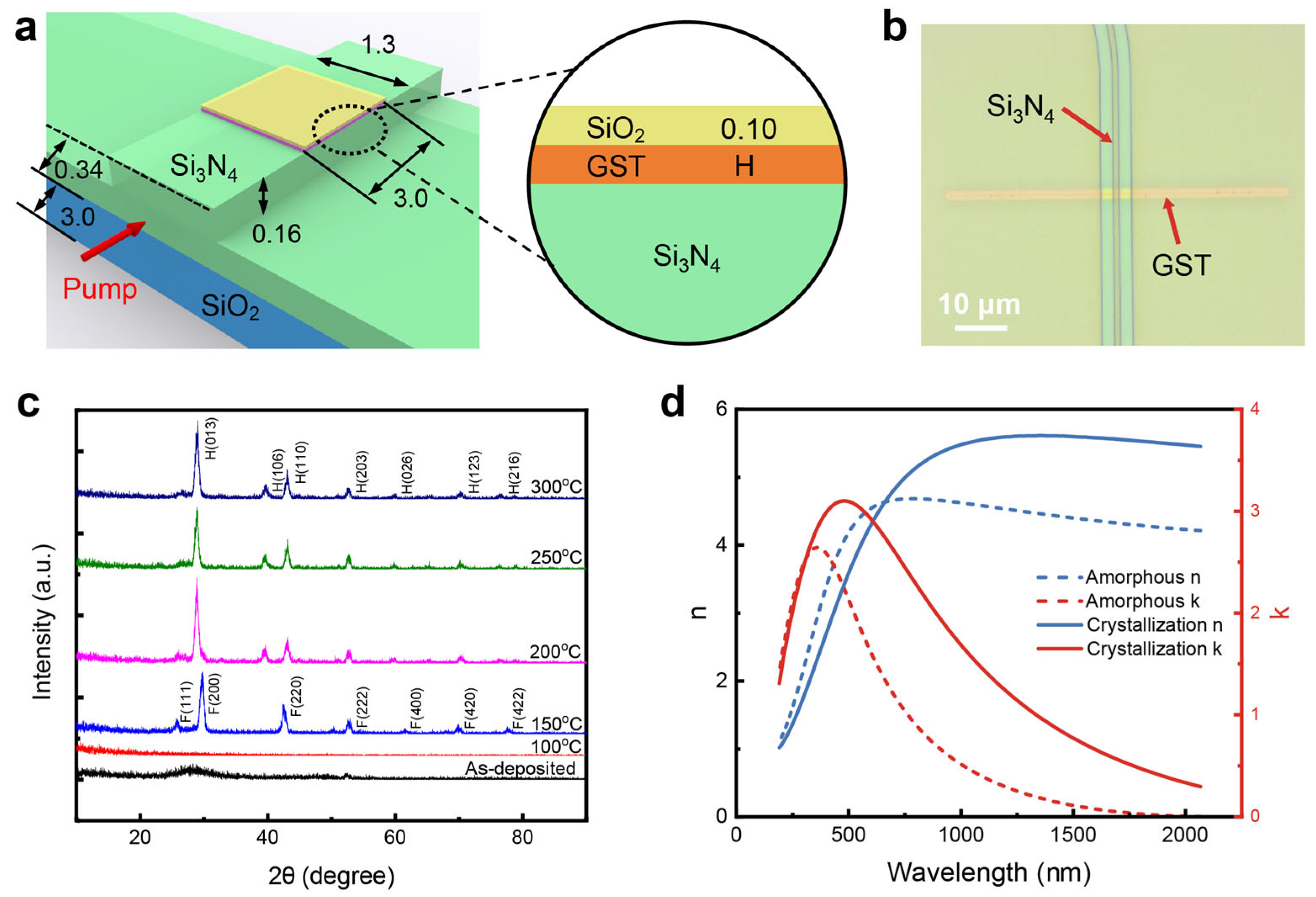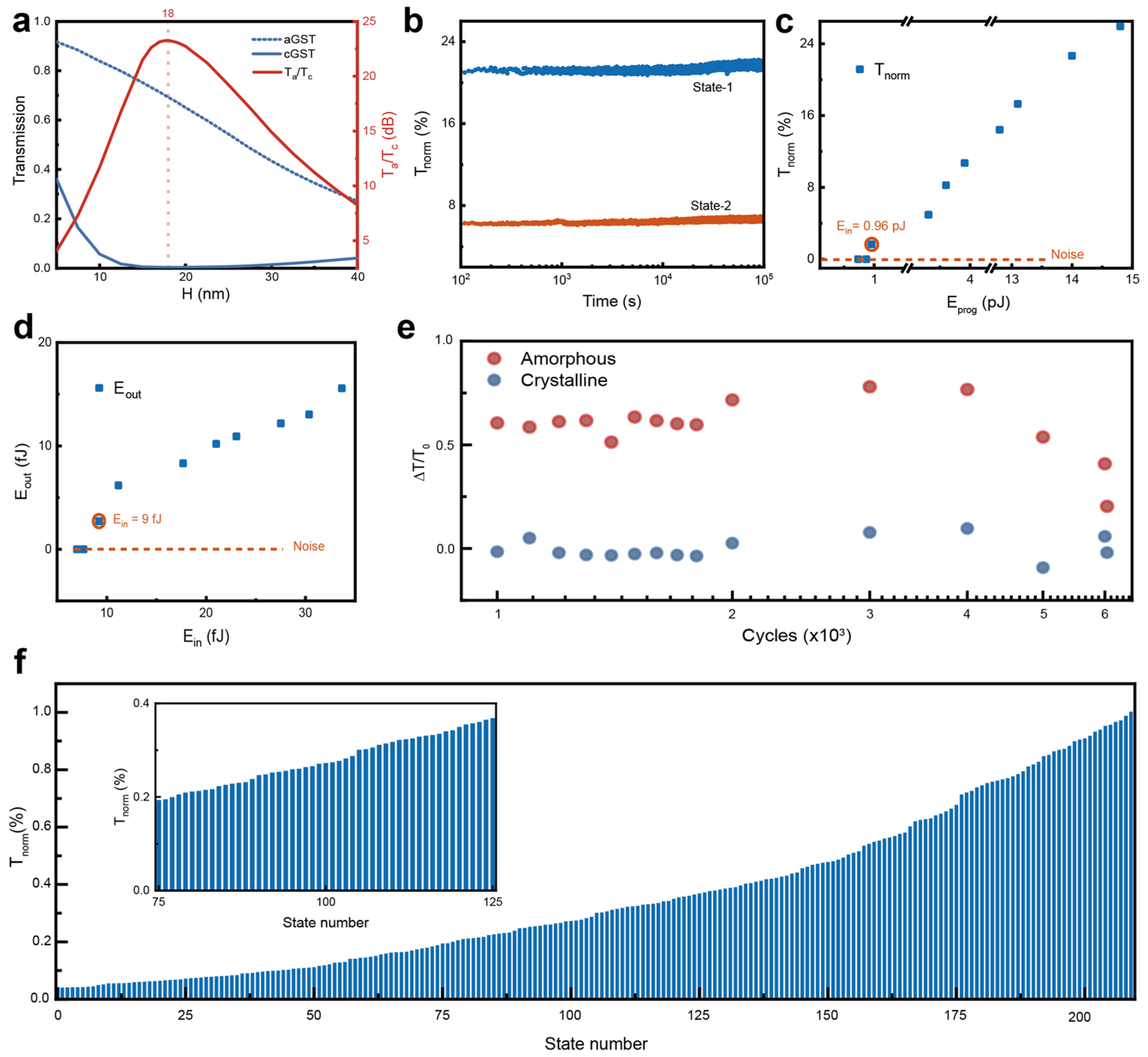Structure-Optimized Photonic Phase-Change Memory Achieving High Storage Density and Endurance Towards Reconfigurable Telecommunication Systems
Abstract
1. Introduction
2. Materials and Methods
3. Thickness Design of Photonic Phase-Change Memory
4. Photonic Phase-Change Memory Based on Nanopattern Array
- (1)
- Uniform GST film (Figure 3b): A uniform 20 nm thick GST film (2 μm long) is deposited on the waveguide. In the amorphous state (top panel), its low refractive index minimally disrupts the guided TE mode, yielding a symmetric, low-loss field profile. Upon crystallization, the film’s high absorption suppresses the E-field dramatically, enabling strong modulation depth (10.85 dB; see Table 1) but introducing high insertion loss and limited spatial control due to its continuous geometry.
- (2)
- Hybrid nanodisc design (Figure 3c): This configuration combines a 10 nm GST underlayer with a nanodisc array (100 nm diameter, 50 nm height, 200 nm pitch). In the amorphous phase, the disks weakly perturb the mode, maintaining low loss. When crystallized, the high index contrast confines the E-field to the disks and air gaps, forming a standing wave. This design achieves comparable modulation depth (9.925 dB, Table 1) to the uniform film but reduces propagation loss, offering a superior trade-off for scalable integration.
- (3)
- Full metasurface (Figure 3d): Here, GST nanodiscs are fully etched into the waveguide (no underlayer). The amorphous state supports a Bloch-like mode with high transmission, while crystallization induces localized field enhancement in the disks. Without a continuous absorbing layer, losses remain low, but the modulation depth (1.233 dB, Table 1) drops compared to the hybrid design (Figure 3c), making it better suited for low-loss phase modulation.
5. Discussion
6. Conclusions
Supplementary Materials
Author Contributions
Funding
Data Availability Statement
Conflicts of Interest
References
- Wang, W.; Jin, J.; Wang, Y.; Wei, Z.; Xu, Y.; Peng, Z.; Liu, H.; Wang, Y.; You, J.; Impundu, J.; et al. High-speed optoelectronic nonvolatile memory based on van der Waals heterostructures. Small 2023, 19, 2304730. [Google Scholar] [CrossRef]
- Yu, J.; Wang, H.; Zhuge, F.; Chen, Z.; Hu, M.; Xu, X.; He, Y.; Ma, Y.; Miao, X.; Zhai, T. Simultaneously ultrafast and robust two-dimensional flash memory devices based on phase-engineered edge contacts. Nat. Commun. 2023, 14, 5662. [Google Scholar] [CrossRef]
- Tossoun, B.; Liang, D.; Cheung, S.; Fang, Z.; Sheng, X.; Strachan, J.P.; Beausoleil, R.G. High-speed and energy-efficient non-volatile silicon photonic memory based on heterogeneously integrated memresonator. Nat. Commun. 2024, 15, 551. [Google Scholar] [CrossRef] [PubMed]
- Zhao, L.; Fang, H.; Wang, J.; Nie, F.; Li, R.; Wang, Y.; Zheng, L. Ferroelectric artificial synapses for high-performance neuromorphic computing: Status, prospects, and challenges. Appl. Phys. Lett. 2024, 124, 030501. [Google Scholar] [CrossRef]
- Shrestha, P.R.; Zaslavsky, A.; Jimenez, V.O.; Campbell, J.P.; Richter, C.A. Impact-ionization-based high-endurance one-transistor bulk CMOS cryogenic memory. IEEE J. Electron Devices Soc. 2025, 13, 355–361. [Google Scholar] [CrossRef]
- Wen, J.; Yi, C.; Chen, J.; Wang, L.; Liu, Z.; Chen, Z.; Tong, H.; Miao, X. Write endurance enhanced and large memory window of GeSe-based selector-only memory with indium doping scheme. IEEE Electron Device Lett. 2025, 46, 115–118. [Google Scholar] [CrossRef]
- Bae, S.J.; Lee, S.H.; Park, J.; Kim, M.S.; Hong, J.W.; Koh, W.S.; Yun, G.S.; Jang, J.; Bae, J.-H.; Kang, I.M. Design of a gate-all-around arch-shaped tunnel-field-effect-transistor-based capacitorless DRAM. Discov. Nano 2025, 20, 64. [Google Scholar] [CrossRef]
- Li, G.; Liu, Z.-Y.; Zhang, C.-X.; Cai, X.; Yan, L.; Zhang, C.; Deng, H.-X. Investigation and passivation of boron and hydrogen impurities in tetragonal ZrO2 dielectrics for dynamic random access memory capacitors. J. Appl. Phys. 2023, 133, 125701. [Google Scholar] [CrossRef]
- Li, Y.; Tang, X.; Miao, S.; Peng, J.; Xu, G.; Hu, X.; Bai, W.; Liu, Z.; Lu, D.; Long, S. Improved dielectric constant and leakage current of ZrO2-based metal-insulator-metal capacitors by Si doping. IEEE Trans. Electron Devices 2024, 71, 4914–4919. [Google Scholar] [CrossRef]
- Pappas, C.; Moschos, T.; Alexoudi, T.; Vagionas, C.; Pleros, N. Caching with light: A 16-bit capacity optical cache memory prototype. IEEE J. Sel. Top. Quantum Electron. 2023, 29, 6100911. [Google Scholar] [CrossRef]
- Nurgali, A.; Nakarmi, B.; Molardi, C.; Ukaegbu, I.A. 4 × 4 bit programmable optical memory array with digital addressing using micro-ring resonators. IEEE Access 2024, 12, 13822–13832. [Google Scholar] [CrossRef]
- Zhang, Y.; Chou, J.B.; Li, J.; Li, H.; Du, Q.; Yadav, A.; Zhou, S.; Shalaginov, M.Y.; Fang, Z.; Zhong, H.; et al. Broadband transparent optical phase change materials for high-performance nonvolatile photonics. Nat. Commun. 2019, 10, 4279. [Google Scholar] [CrossRef]
- Delaney, M.; Zeimpekis, I.; Lawson, D.; Hewak, D.W.; Muskens, O.L. A new family of ultralow loss reversible phase-change materials for photonic integrated circuits: Sb2S3 and Sb2Se3. Adv. Funct. Mater. 2020, 30, 2002447. [Google Scholar] [CrossRef]
- Wuttig, M.; Bhaskaran, H.; Taubner, T. Phase-change materials for non-volatile photonic applications. Nat. Photonics 2017, 11, 465–476. [Google Scholar] [CrossRef]
- Ríos, C.; Stegmaier, M.; Hosseini, P.; Wang, D.; Scherer, T.; Wright, C.D.; Bhaskaran, H.; Pernice, W.H.P. Integrated all-photonic non-volatile multi-level memory. Nat. Photonics 2015, 9, 725–732. [Google Scholar] [CrossRef]
- Aggarwal, S.; Milne, T.; Farmakidis, N.; Feldmann, J.; Li, X.; Shu, Y.; Cheng, Z.; Salinga, M.; Pernice, W.H.P.; Bhaskaran, H. Antimony as a programmable element in integrated nanophotonics. Nano Lett. 2022, 22, 3532–3538. [Google Scholar] [CrossRef]
- Chen, X.Z.; Xue, Y.; Sun, Y.B.; Shen, J.B.; Song, S.N.A.; Zhu, M.; Song, Z.T.; Cheng, Z.G.; Zhou, P. Neuromorphic photonic memory devices using ultrafast, non-volatile phase-change materials. Adv. Mater. 2023, 35, 2203909. [Google Scholar] [CrossRef]
- Yang, X.; Lu, L.; Li, Y.; Wu, Y.; Li, Z.; Chen, J.; Zhou, L. Non-volatile optical switch element enabled by low-loss phase change material. Adv. Funct. Mater. 2023, 33, 2304601. [Google Scholar] [CrossRef]
- Sun, H.; Lian, C.; Vásquez-Aza, F.; Rahimi Kari, S.; Huang, Y.-S.; Restelli, A.; Vitale, S.A.; Takeuchi, I.; Hu, J.; Youngblood, N.; et al. Microheater hotspot engineering for spatially resolved and repeatable multi-level switching in foundry-processed phase change silicon photonics. Nat. Commun. 2025, 16, 4291. [Google Scholar] [CrossRef]
- Gao, C.; Shen, J.; Chen, X.; Cheng, Z.; Zhou, P. Structural optimization of integrated non-volatile photonic memory towards high storage density and low energy consumption. Opt. Mater. Express 2022, 12, 2668–2678. [Google Scholar] [CrossRef]
- Wei, M.; Xu, K.; Tang, B.; Li, J.; Yun, Y.; Zhang, P.; Wu, Y.; Bao, K.; Lei, K.; Chen, Z.; et al. Monolithic back-end-of-line integration of phase change materials into foundry-manufactured silicon photonics. Nat. Commun. 2024, 15, 2786. [Google Scholar] [CrossRef] [PubMed]
- Wu, C.; Yu, H.; Li, H.; Zhang, X.; Takeuchi, I.; Li, M. Low-loss integrated photonic switch using subwavelength patterned phase change material. ACS Photonics 2019, 6, 87–92. [Google Scholar] [CrossRef]
- Wu, C.; Yu, H.; Lee, S.; Peng, R.; Takeuchi, I.; Li, M. Programmable phase-change metasurfaces on waveguides for multimode photonic convolutional neural network. Nat. Commun. 2021, 12, 96. [Google Scholar] [CrossRef]
- Ríos, C.; Youngblood, N.; Cheng, Z.; Le Gallo, M.; Pernice, W.H.P.; Wright, C.D.; Sebastian, A.; Bhaskaran, H. In-memory computing on a photonic platform. Sci. Adv. 2019, 5, eaau5759. [Google Scholar] [CrossRef]
- Stegmaier, M.; Ríos, C.; Bhaskaran, H.; Wright, C.D.; Pernice, W.H.P. Nonvolatile all-optical 1 × 2 switch for chipscale photonic networks. Adv. Opt. Mater. 2017, 5, 1600346. [Google Scholar] [CrossRef]
- Saha, N.; Brunetti, G.; Ciminelli, C. Highly efficient phase change material assisted reconfigurable optical delay line based on cascaded coupled-resonator optical waveguides. J. Light. Technol. 2025, 43, 8274–8285. [Google Scholar] [CrossRef]
- Chen, H.; Jia, H.; Yang, J.; Tian, Y.; Wang, T. Ultra-compact switchable mode converter based on silicon and optical phase change material hybrid metastructure. Opt. Commun. 2020, 473, 125889. [Google Scholar] [CrossRef]
- Wang, T.; Jia, H.; Chen, H.; Yang, J. Phase-change material assisted on-chip wavefront shaping for optical switching and beam splitting. Opt. Commun. 2023, 527, 128974. [Google Scholar] [CrossRef]
- Li, X.; Youngblood, N.; Ríos, C.; Cheng, Z.; Wright, C.D.; Pernice, W.H.P.; Bhaskaran, H. Fast and reliable storage using a 5 bit, nonvolatile photonic memory cell. Optica 2019, 6, 1–6. [Google Scholar] [CrossRef]
- Chen, R.; Fang, Z.; Fröch, J.E.; Xu, P.; Zheng, J.; Majumdar, A. Broadband nonvolatile electrically controlled programmable units in silicon photonics. ACS Photonics 2022, 9, 2142–2150. [Google Scholar] [CrossRef]
- Xia, J.; Wang, T.; Wang, Z.; Gong, J.; Dong, Y.; Yang, R.; Miao, X. Seven bit nonvolatile electrically programmable photonics based on phase-change materials for image recognition. ACS Photonics 2024, 11, 723–730. [Google Scholar] [CrossRef]
- Chen, R.; Tara, V.; Choi, M.; Dutta, J.; Sim, J.; Ye, J.; Fang, Z.; Zheng, J.; Majumdar, A. Deterministic quasi-continuous tuning of phase-change material integrated on a high-volume 300-mm silicon photonics platform. npj Nanophotonics 2024, 1, 7. [Google Scholar] [CrossRef]
- Chen, R.; Fang, Z.; Perez, C.; Miller, F.; Kumari, K.; Saxena, A.; Zheng, J.; Geiger, S.J.; Goodson, K.E.; Majumdar, A. Non-volatile electrically programmable integrated photonics with a 5-bit operation. Nat. Commun. 2023, 14, 3465. [Google Scholar] [CrossRef] [PubMed]




| Film Layer Height (nm) | Micro-Cylinder Height (nm) | Tra | Trc | Tra/Trc (dB) |
|---|---|---|---|---|
| 20 | 0 | 0.550 | 0.045 | 10.850 |
| 10 | 50 | 0.443 | 0.045 | 9.925 |
| 5 | 50 | 0.795 | 0.143 | 7.450 |
| 0 | 50 | 0.894 | 0.673 | 1.233 |
| Ref. | Materials | Structure | Modulation Speed (ns) | Consumption (pJ/Operation) | Storage Density (Bit) | Endurance (Cycles) |
|---|---|---|---|---|---|---|
| This work | GST | Height-optimized film (nanodisc array) | 10 | 0.96 | 7.71 | 6000 (film) 2 × 106 (array) |
| [29] | GST | Uniform film | 25 | 680 | 5.09 | -- |
| [30] | GST | Uniform film + PIN junction + DC 1 | 200 | 3.8 × 105 | -- | 2800 |
| [31] | N-GST 2 | Uniform film + ITO heater 3 | 5 × 104 | -- | 7.79 | 400 |
| [16] | Sb | Uniform film | 8 × 10−4 | 45 | 2.81 | 50 |
| [18] | Sb2Se3 | Uniform film (sub-cell array) + PIN junction + MZI | 100 | 6.4 × 104 | 5 (film) 6 (array) | 3000 (film) 1 × 104 (array) |
| [32] | Sb2S3 | Uniform film + PIN junction | 500 | 1.22 × 106 | 3 | 2500 |
| [33] | Sb2S3 | Uniform film + PIN junction | 150 | 5.6 × 104 | 5 | 800 |
Disclaimer/Publisher’s Note: The statements, opinions and data contained in all publications are solely those of the individual author(s) and contributor(s) and not of MDPI and/or the editor(s). MDPI and/or the editor(s) disclaim responsibility for any injury to people or property resulting from any ideas, methods, instructions or products referred to in the content. |
© 2025 by the authors. Licensee MDPI, Basel, Switzerland. This article is an open access article distributed under the terms and conditions of the Creative Commons Attribution (CC BY) license (https://creativecommons.org/licenses/by/4.0/).
Share and Cite
Gao, C.; Han, Z.; Wang, G.; Huang, W. Structure-Optimized Photonic Phase-Change Memory Achieving High Storage Density and Endurance Towards Reconfigurable Telecommunication Systems. Photonics 2025, 12, 1130. https://doi.org/10.3390/photonics12111130
Gao C, Han Z, Wang G, Huang W. Structure-Optimized Photonic Phase-Change Memory Achieving High Storage Density and Endurance Towards Reconfigurable Telecommunication Systems. Photonics. 2025; 12(11):1130. https://doi.org/10.3390/photonics12111130
Chicago/Turabian StyleGao, Chen, Zhou Han, Gaofei Wang, and Wentao Huang. 2025. "Structure-Optimized Photonic Phase-Change Memory Achieving High Storage Density and Endurance Towards Reconfigurable Telecommunication Systems" Photonics 12, no. 11: 1130. https://doi.org/10.3390/photonics12111130
APA StyleGao, C., Han, Z., Wang, G., & Huang, W. (2025). Structure-Optimized Photonic Phase-Change Memory Achieving High Storage Density and Endurance Towards Reconfigurable Telecommunication Systems. Photonics, 12(11), 1130. https://doi.org/10.3390/photonics12111130




